|
|
 |
|
Misophrioida ( Order ) |
|
|
|
Speleophriidae ( Family ) |
|
|
|
Speleophriopsis ( Genus ) |
|
|
| |
Speleophriopsis mljetensis Krsinic, 2017 (F,M) | |
| | | | | | | Ref.: | | | Krsinic, 2017 (p.942, Descr.F, M, figs.F, M, Table 1, Rem.) | 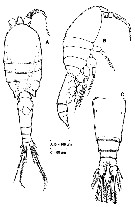 Issued from F. Krsinic in Mar. Biol., 2017, 47. [p.942, Fig.1]. Female (from Bjejajka Cave, Mljet Island): A-B, habitus (dorsal and lateral, respectively); C, urosome (dorsal). Nota: - Body cyclopiform in dorsal aspect. - Nauplius absent. - Prosome 5-segmented. - Cephalosome and 1st pediger separate. - Pediger 4 with posterior margins expandecd laterally in dorsal view. - Rostrum well developed, rounded in dorsal aspect. - Proportional lengths of prosome segments: 56 : 11 : 14 : 12 : 7 = 100. - Ratio Prosome: Urosome including caudal rami = 1.5 : 1. - Prosome 2.1 times long as wide. - Urosome 5-segmented; - Proportional lengths of urosomites and caudal rami: 17 : 47 : 14 : 9 : 5 : 9 = 100. - 2nd to 4th urosomites each with hyaline frill along posterior margin. - Genital double-somite 1.4 times longer than wide, with vestige of suture line between component somites visible ventrally. - Caudal rami symmetrical, about 1.3 times longer than wide; each ramus with 7 setae, 4 terminal corresponding to setae III-VI, seta I well developed, tuft of fine spinules present on inner margin of ramus.
|
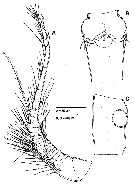 Issued from F. Krsinic in Mar. Biol., 2017, 47. [p.943, Fig.2]. Female: A, A1; B-C, genital double-somite (ventral and lateral, respectively). Nota: - A1 implanted on trapezoidal pedestal, symmetrical, 27-segmented, longer than cephalosome; segments 2 to 17 very short, segments 20 to 27 each about 2 times longer than wide. Aesthetascs on segments 3 and 7 hypertrophied. - Genital double-somite with genital area symmetrical, located proximp-ventrally, with single small median copulatory pore, and paired genital opercula located laterally, each opercumlum ornamented with naked seta, long spine and small denticle. - All females with single egg (50 µm in diameter) in medial position.
|
 Issued from F. Krsinic in Mar. Biol., 2017, 47. [p.943, Fig.3]. Female: A, A2; B, Md; C, Mx1; D, Mx2; E, Mxp. Nota: - A2 biramous. Coxa and basis unarmed. Endopod 2-segmented, longer than exopod; proximal segment with 2 setae distally on inner margin, distal segment elongate with 5 setae proximally and 6 setae at tip. Exopod 7-segmented (setal formula 1, 1, 1, 1, 1, 1, 5). - Md: coxa sickle-shaped, not ornamented, gnathobase cutting edge with isolated unicuspid tooth and 10 heterogeneous teeth, lateral extremity of coxa expanded. Basis longer than wide with single seta on medial margin. Endopod 2-segmented, 1st segment withb 1 seta and terminal segment with 7 setae. Exopod 5-segmented (setal formula 1, 1, 1, 1, 2). - Mx1: praecoxal arthrite bearing 10 stout pectinate spines, 3 setae on proximal part and 2 setae on posterior surface; coxal epipodite with 7 plumose setae, coxal endite with 4 setae; proximal basal endite with 3 slender setae and 1 stout seta, distal basal endite with 4 exite represented by short seta; endopod 1-segmented, with 5 slender distal setae, 1 stout seta, 2 subdistal and 2 lateral shorter setae; exopod with 7 distal and 2 lateral setae. - Mx2 6-segmented. Praecoxal endites with 6 and 3 setae, respectively; coxal endites with 3 and 3 setae, respectively; allobasis with proximal endite powerfully developed, ornamented with short setules, bearing 5 setae proximally and 3 setae distally; free endopod 3-segmented (setal formula 2, 2, 4). - Mxp 8-segmented; praecoxal endite with 1 seta, coxal endites incorporated into segment (setal formula 2, 4, 3); basis triangular with 3 setae in inner median position, outer lateral margin ornamented with spinules; endopod (setal formula 1, 2, 2, 2, 2 + 1, 4 + 1), distal segment elongate
|
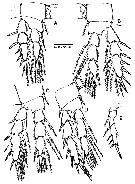 Issued from F. Krsinic in Mar. Biol., 2017, 47. [p.944, Fig.4]. Female: A, P1; B, P2; C, P3; D, P4; E, P5. Nota: - P5 symmetrical, uniramous, 4-segmented. Coxa unarmed; basis longer than coxa, with outer plumose seta on submarginal surface, inner margin rounded. Exopod 2-segmented, proximal segment longer than basis, with naked spine on outer margin; disal segment 2.5 times longer than proximal, ornamented distally with row of very fine setules, with 3 denticulate spines on outer margin and small naked spine on inner margin, long distal denticulate spine, with denticles along inner margin covering only distal part, and short subdistal seta.
|
 Issued from F. Krsinic in Mar. Biol., 2017, 47. [p.944]. Female & Male: Armature formula of swimming legs P1 to P5 (seta: Arabic numerals; spine: Roman numerals)
|
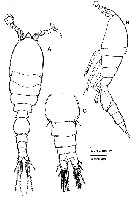 Issued from F. Krsinic in Mar. Biol., 2017, 47. [p.945, Fig.5]. Male: A-B, habitus (dorsal and lateral, respectively); C, urosome (dorsal). Nota: - Prosome 2.4 times longer than wide. - Cephalosome and pedigerous somites similar to those of female. - Rostral area as in female. - Prosome : Urosome ratio = 1.6 : 1. - Urosome 6-segmented. - Proportional lengths of urosomites and caudal rami 7 : 36 : 23 : 13 : 5 : 6 : 10 = 100. - Genital somite symmetrical, approximately asz wide as long, slighrly expanded dorso-ventrally; paired gental apertures armed with 3 unequal setae representing P6. - Caudal rami as in female. A2, mouth parts and swimming legs 1-4 identical to those of female.
|
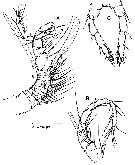 Issued from F. Krsinic in Mar. Biol., 2017, 47. [p.945, Fig.6]. Male: A, right A1; B, distal part of left A1; C, P5. Nota: - Propximal part of 27-segmented A1 similar to that of female. Distal part of left A1 typically bent inwards while, in right A1, making loop to outside. Geniculation present between ancestral segments XX and XXI on both sides; segment XV cup-shaped; segment XVI longer than wide and with large part incorporated inj segment XV; segments 2-15 condensed; broad articulations present between segments 16-18, with rounded margin anteriorly. Segmental setation pattern as follows: segments 1-17 as for female; segments 18 and 19, 1seta+spine; segment 20, 1 seta; segment 21, 2 spines+aesthetasc (left A1), 1 spine (right A1); segment 22, 1 spine; segment 23, 1 seta; segment 24, 2 setae; segment 25, 2 setae+ aesthetasc; segment 26, 2 setae; segment 27, 5 setae+ aesthetasc. - P5 uniramous, symmetrical. Coxa unarmed. Basis longer than coxa, with outer naked seta on submarginal surface, inner margin rounded. Both exopodal segments relatively longer than in female; naked spine on outer margin of proximal segment smaller than spine in female; distal segment with 3 spines on outer margin as in female, distal spine and short seta, and with 2 elements on inner margin, proximal pinnate seta and subdistal truncate spine ornamented with denticles on both margins.
|
 Issued from F. Krsinic in Mar. Biol., 2017, 47. [p.946, Table 1]. Comparative characteristics forv species S. balearicus, S. canariensis and S. mljetensis.
| | | | | NZ: | 1 | | |
|
Distribution map of Speleophriopsis mljetensis by geographical zones
|
| | | | | | | Loc: | | | Medit. (Mljet Is, Central Adriatic Sea)
Type locality: 42°45'55.5'' N, 17°23'08.4'' E. | | | | N: | 1 | | | | Lg.: | | | (1250) F: 0,60-0,77; M: 0,62-0,68; {F: 0,60-0,77; M: 0,62-0,68} | | | | Rem.: | Krsinic (2017, p.945): this species was found in the anchialine cave on the island of Mljet, located near the deepest part of the central Adriatic Sea (maximum depth: 1250 m). The salinity varied between 1.5 at the surface and 39 psu at the bottom, temperature ranged between 14.2 and 16.6 °C; Oxygen concentration was at its lowest at 4 m depth (0.14 µg/l, while significantly higher values were found near the bottom during January (2009). The highest population density was found in the deeper parts of the cave, where there were significantly higher values of oxygen and salinity.The new species is similar to S. balearicus and S. canariensis; differences from S. campaneri and S. scottodicarloi are most obvious. According to Jaume & Boxshall (1996), body segmentation and armature of all appendages are virtually indentical in S. balearicus and S. canariensis, except the armature of the genital operculum and P5. The genital operculum of S. mljetensis is armed with a slender naked seta, a shorter stout spine and a small denticle. In S. balearicus, it is armed with 2 setae, while in S. canariensis, it carries a long plumose seta, a short stout spine and a tiny denticle. The tip of the outer spine on the 1st exopodal segment of P5 in the females does not reach the tip of the proximal spine on the 2nd segment in S. mljetensis and in S. canariensis, while in S. balearicus, this outer spine is the same length as the 2nd segment and reaches the tip of the proximal spine on the 2nd segment. The terminal spine on the 2nd exopodal segment is only as long as that segment in S. mljetensis; however, the distal seta is much shorter than in S. balearicus and is not pinnate. The P5 males also differs between S. canariensis, S. balearicus and S. Mljetensis. | | | Last update : 15/02/2020 | |
|
|
 Any use of this site for a publication will be mentioned with the following reference : Any use of this site for a publication will be mentioned with the following reference :
Razouls C., Desreumaux N., Kouwenberg J. and de Bovée F., 2005-2025. - Biodiversity of Marine Planktonic Copepods (morphology, geographical distribution and biological data). Sorbonne University, CNRS. Available at http://copepodes.obs-banyuls.fr/en [Accessed December 27, 2025] © copyright 2005-2025 Sorbonne University, CNRS
|
|
 |
 |









